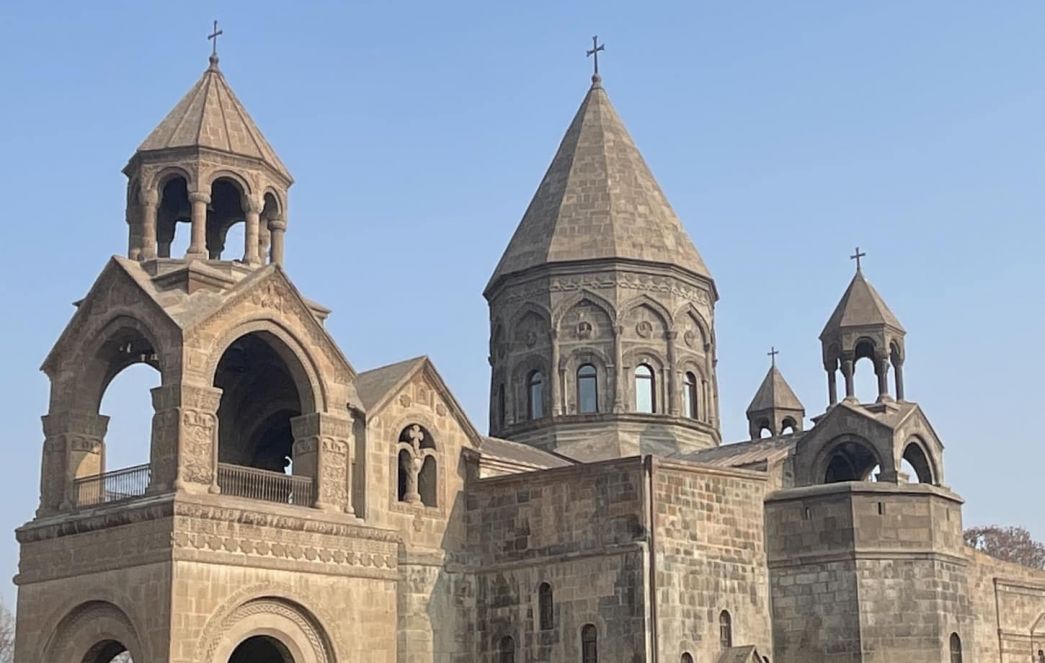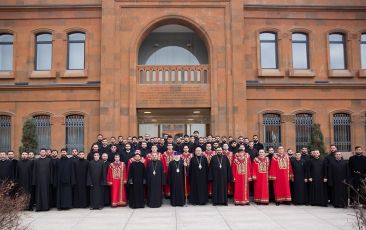The letter of the Educational Committee of the Mother See of Holy Etchmiadzin regarding the 7th grade textbook for the subject "Armenian History" addressed to the Minister of Education and Culture of the Republic of Armenia
 26.12.2023
26.12.2023
November 24, 2023
HONORABLE
MRS ZHANNA ANDREASIAN
MINISTER OF ESCS OF RA
Yerevan
Dear Minister,
We are writing this letter to you regarding a number of key omissions and errors in the preparation process and content of the 7th grade “Armenian History” subject of the Public School, expecting your rightful intervention.
We would like to remind you that once, the Church, represented by the Committee on Educational Affairs of the Mother See of Holy Etchmiadzin (hereinafter referred to as the Committee), both during the discussions with the representatives of your department and publicly, expressed his concerns regarding the unacceptable approaches adopted by the ministry to the subject of Armenian studies in the state and subject standards of General Education, particularly the "History of the Armenian Church", which are highly disputed from the point of view of constitutionality and legality. It was obvious that as a result of the "reforms" of the Ministry, more than 70% of the entire volume of the "History of the Armenian Church" course is left out of the general education programs. However, contrary to the substantive reservations of the Church, as well as scientific, educational and public spheres, the ministry, with incomprehensible persistence, decided to organize education according to the mentioned standards.
During this academic year, we had the opportunity to get acquainted with some of the textbooks prepared according to the mentioned standards, in particular, the 7th grade textbook of the "Armenian History" subject, which, unfortunately, contains the worst solutions predicted by us, about which representatives of the scientific and educational community have already expressed concerns and complaints.
In order to make the mentioned more objective and argumentative, below we present some observations of the Committee regarding the textbook:
A: CURRENT PROCEDURE ISSUES
1. Reasonable mistrust of the process of preparing the textbook is caused by the fact that such prestigious professional structures as the Institute of History of the National Academy of Sciences, the respective faculties of YSU and ASPU were not involved in it, and no such high-ranking and responsible institution has expressed itself in favor of guaranteeing their publication and use.
The involvement of such educational institutions was necessary, especially considering the fact that this textbook was surprisingly prepared by only one person, and that is not a specialist in Armenian history, but a specialist in World history. However, it should be noted that the textbook covers different periods of history, and one person should not be able to specialize in such a wide range of topics. Therefore,it causes uncertainty that the ministry, a supporter of democratic values, does not provide the necessary professional discussions, transparency and publicity in such an important process as the organization of education and upbringing of generations.
2. It is very strange that the textbook does not even meet the requirements set by the subject standards and the program. According to the Armenian History 7th grade standard program, the new textbook should include the following topics:
- in topic 4: The emergence and spread of Christianity; Christianity as a pillar of Armenian civilization; Christian doctrine. The Bible; the expansion of the role and influence of the Armenian Church in the region; the hierarchy of the Armenian Church; the sacraments, the structure of the churches; National-Church Assemblies,
- topic 5: War of Vardanants, Universal Assemblies and the Armenian Church, the Armenian Church VII-VIII centuries,
- topic 7: The Armenian Church in the Bagratuniants period.
Even from a cursory reading of the textbook, it is obvious that the textbooks on the above topics are either completely absent, or the ones presented are incomplete and fragmentary, and the student simply cannot get the least idea about the material.
The consequence is one: the ministry has not demonstrated consistency even in maintaining the standards set by itself.
3. At the beginning of the textbook there is a reference, in which the "author group" also expresses gratitude to the Mother See of Holy Etchmiadzin for supporting the creation of the textbook. We do not think that the expression of gratitude is a mere display of courtesy, but a deliberate attempt to create a false impression that the Mother See of Holy Etchmiadzin participated in the preparation of the textbook, which is completely untrue. On the contrary, the Mother See of Holy Etchmiadzin has officially categorically opposed the preparation of textbooks with established standards.
B: TEXTBOOK CONTENT
Referring to the serious historical, ecclesiological and terminological omissions and errors in the content of the textbook, let us record:
1.As a general observation, the position adopted by the author towards the most important national symbols (Ararat, Masis, Hayk Nahapet, Mother Cathedral of Holy Etchmiadzin) is very worrying and unacceptable.
Thus, a/ Ararat is mentioned from my side, and just out of the need to pass on a cursory geographical knowledge, leaving silent the importance of the sacred mountain not only for Armenians, but also for the whole world as the second birthplace of humanity.
b/ The author considers it necessary to remember Hayk Nahapet only once, as the supposed ancestor of Paruyr Skyordi, keeping silent about the Hayk-Bel conflict, the origin of the Armenian people and the decisive role of Hayk's victory in the formation of ethnopsychology.
c/ The construction of the Holy Etchmiadzin Cathedral (whose universal sanctity and charm no one and nothing has been able to degrade over the past 17 centuries) is presented as an ordinary episode of the historical annals, thus trying to overshadow the importance and role and significance of the longest and continuously operating structure in Armenian reality in the life of the nation and the Armenian people.
2. It is even more strange that King Trdat III is presented as the founder of the Armenian Church in the textbook: "In 301, Trdat III was the first in the world to declare Christianity as the state religion and founded the Armenian Apostolic Church" (p. 111). Meanwhile, it was necessary to mention the historical fact that through the efforts of Patriarch Gregory the Illuminator, Christianity was declared the state religion in Armenia by King Trdat, and the founder of the Church is Christ, by the preaching of the apostles St. Thaddeus and S. Bartholomew.
3.The claim that "Grigor Parthev was appointed Armenian Patriarch by the king" is also surprising (page 111). It should be noted that receiving an ecclesiastical rank is not done by appointment, but through the Council of Ordination, and assuming the mission of the Catholicos of Armenia is done by election. In this regard, it is recommended to avoid wrong assumptions by reading or re-reading historical evidences regarding Gregory the Illuminator assuming the service of the Armenian Patriarch.
4.The episode of the martyrdom of the apostle St. Thaddeus is a false narrative. The author writes that the apostle "departs... to the royal court of the Armenian king Sanatruk, where he is martyred" (p. 109), which is definitely a historical distortion and error.
5.The description of the section about the Hripsimians virgins in the textbook is also problematic: "Avoiding the persecution of Christians, they eventually took refuge in Armenia, where they were martyred. According to tradition, the cause of the persecution was Hripsime of the virgins" (p. 111), which does not correspond to historical reality and itself gives rise to misinterpretations.
6.Another part of the textbook suddenly reveals that Christianity was established in Armenia thanks to the favor of the Roman Emperor Diocletian. The author of the textbook, bypassing the original sources, presents his personal, baseless assumption: "Despite his initial hostility to Christianity, the Roman emperor Diocletian (284-305) tolerated the establishment of Christianity in Armenia, as it was seen more as a manifestation of contrast to the Sasa
7.The history of the creation of Armenian letters and the conclusion about the motives are also presented with arbitrary and unconvincing comments: "The best way to preserve the royal and church power was the unifying factor of the Armenian language" (p. 148).
8.The fact that the battle of Avarair is presented in the textbook with a deliberate misinterpretation, belittling and distortions of the heroes and their feats is unacceptable. It is strictly unacceptable to fix the point of view in the textbook that gives the impression that St. Vardan Mamikonyan was short-sighted, adventurous, lacking diplomatic skills, recklessly dragging the country into war. And Vasak Syun, who betrayed the liberation struggle and the Armenian army, is presented as a supporter of peace and a connoisseur of negotiations.
The great role of the Catholicos St. Hovsep I of Hogotsmets in this liberation struggle, on whose initiative in 449 the meeting of Artashat was convened, is completely ignored. The energetic activity of St. Ghevond Yerets in order to inspire the Armenian people to fight against the enemy is not mentioned in any way. References to the martyrdom of the clergy have been left out. The video embedded in the textbook with a QR code at the end of this topic is also not acceptable, in which the speaker, speaking critically about the battle of Avarayr, questions the validity of certain information provided by the historian St. Yeghishe, even his authorship.
It is incomprehensible and reprehensible to reduce the significance and role of the battle of Avarair, which is of great importance in the formation of national spirit, identity and patriotism in the life of our people worldwide, and to devalue this struggle, contrary to the centuries-old cherished perception of our people and the evaluations and qualifications accepted in historiography.
9.The author of the textbook does not accurately present the church materials, ecclesiological concepts, such as, for example, the hierarchal order of the Armenian Church: "The spiritual hierarchy of the Armenian Apostolic Church, which has the following divisions: Catholicos, Patriarch, Archbishop, Reverend, Priest, Deacon, Scribe" (page 108). The submitted list is unacceptable, incorrect and incomplete. It was just a real "discovery" that the rank of bishop does not exist in the canonical hierarchy of the Armenian Church, and canonical degrees are limited to 7 instead of 9. Meanwhile, in order to get acquainted with the canonical hierarchy of the Armenian Church, one only had to use the textbook of the 6th grade on the subject "History of the Armenian Church" (page 14).
10.The textbook does not convey information about the sacraments of the Armenian Church at all. The only exception is a somewhat fragmentary and obscure account of the Council of Ordination. "Religious order, one of the seven sacraments of the Armenian Church, by which one becomes a clergyman and is authorized to perform various religious rites and ceremonies" (p. 108). It is self-evident and clear that the mentioned explanation gives an incomplete picture of the Council of Ordination.
11.In the textbook, there is a general tendency to leave out of sight as much as possible, to simply leave in the shadows the fact that clergymen who have made a significant contribution to Armenian history are clergymen, presenting them mainly as cultural figures. Thus, in the chapter "The Golden Age of Armenian Culture" there is no reference to the circumstance of St. Mesrop Mashtots being an Archimandrite (pages 148-149).
Dear Minister, the errors and omissions in the textbook are not limited to this. The problems, errors and omissions raised in relation to the textbook make it obvious that it is not possible to organize the national and quality education and upbringing of generations with such a textbook.
The expectation of our Holy Church is to stop using this textbook and start preparing a new textbook, involving both authoritative representatives of the professional circle and churchmen.
On behalf of the committee,
with prayer and blessing,
ARCHBISHOP MICHAEL AJAPAHYAN
P.S. By the way, years ago, the Ministry of Education republished the textbook authored by Babken Harutyunyan, due to the wrong year of the declaration of Christianity as the state religion in Armenia.




